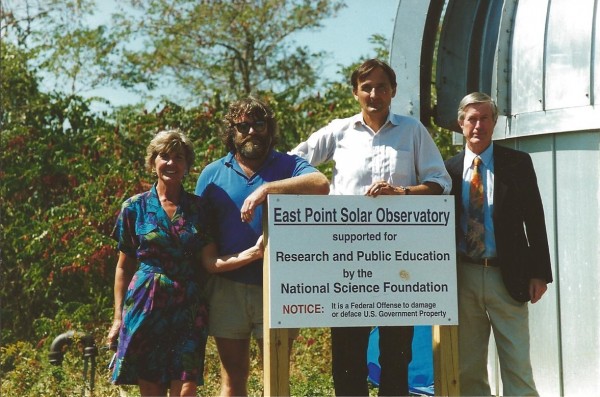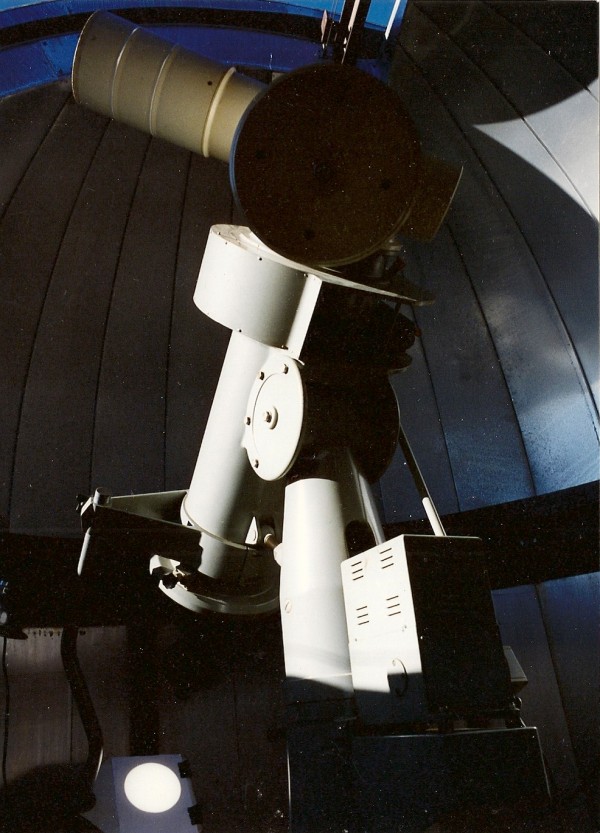18 February 2014
Really Reaching the Public, Face-to-Face
Posted by mcadams

Peter Foukal, second from right, stands next to the East Point Solar Observatory (EPSO) during its inauguration in 1995. Foukal built the Nahant, Mass., observatory to share the wonder of astronomy with the public. From left to right are Mrs. Stephens, Nahant Elementary School science teacher; Dr. J. Ayres, Director of the Northeastern Univ. Marine Sciences Laboratory, Nahant; Peter Foukal; and , R. Carter, Chair of the Nahant School Board. Photo by Elisabeth Foukal.
This story first appeared in the 18 Feb. 2014 issue of Eos.
This past summer I was able to provide a young couple with their first view of Saturn through a telescope, and afterward they told me what a profound experience this look into space had been for them. It wasn’t the first time I’d seen such an emotional response since I opened the East Point Solar Observatory, a small public observatory in Nahant, Mass., in 1995. But listening to them reminded me how lucky we scientists are to pursue a career that brings out such warm feelings in our neighbors. It also made me wonder whether the effectiveness of our national approach to public outreach might be increased by more face-to-face contact between scientists and the public.
Each year the National Science Foundation (NSF) and NASA alone spend close to $1 billion on science education and public outreach (E/PO). Most of this money goes toward curriculum development, traveling exhibits, websites, and other online activities. These programs have a broad reach and can certainly be worthwhile investments. Yet the emotional impact I see on my observatory visitors makes me think that our efforts might have an even greater effect if we balanced them with more direct and personal engagement with the public.
Building Ways to Connect With the Public
For those of us who spend most of our time in a research environment, it is easy to overlook how rare scientists are in the general population. In the Boston area, for instance, the research community lives mostly in Cambridge or in a few suburbs west of the city. Elsewhere, scientists are rare indeed. When my family moved to the outskirts of Boston in 1980, I was aware of only one other person in our town of approximately 4000 doing science for a living. When I visited my children’s classrooms in elementary school, the other kids were amazed to learn that studying the Sun could be a career. Their parents were mainly business people, lawyers, or lobstermen. For these kids, even the idea of research as a career option was a learning experience.
In 1995 I got permission from my NSF program manager to use some of my research grant money to build a small public observatory in Nahant. For the next 3 years I organized a summer astronomy program, drawing a few dozen 9- to 14-year olds to the observatory. With some extra funding added on to my NASA research grant I was able to pay an experienced school teacher and some high-school-aged aides to help run the program, which went on to be a great success in the community. Two summers ago, thanks to a small add-on to another NASA research grant, I was able to repeat the program.

A solar disk is projected onto a screen at the East Point Solar Observatory telescope. Photo by Elisabeth Foukal.
These initiatives were made possible by the understanding and flexibility of the NSF and NASA Solar Terrestrial program managers, who were able to drastically cut down the response time to better mesh with opportunities in student and staff availability. More traditional E/PO channels at NASA or NSF would have required up to 18 months of lead time. Keeping the organization of E/PO funding within the research agencies rather than transferring it to the Department of Education seems more likely to promote face-to-face engagement between practicing scientists and the public.
Listening and Engaging
When it comes to controversial issues like climate change, we are more likely to believe someone we trust than to try to understand the confusing facts ourselves. So conversations between friends and neighbors are often more fruitful than trying to hammer out these debates in the polarized environment of the national media. Face-to-face conversations provide a chance to respond to the specific science questions of our neighbors. I was surprised to learn, for instance, how fascinated kids are by watching the Earth’s rotation move the Sun’s image across a projecting screen when the telescope’s motor is turned off. I would never have guessed that they would consider that as cool as discussing solar flares or black holes.
From my experiences with the East Point Solar Observatory, I’ve realized that getting a family out of the house to clamber up a hill in the evening and watch the observatory dome open has a curiously calming effect. Experiencing the process of doing science is often as interesting to the public as the spectacles of nature themselves. The media tend to sensationalize natural phenomena by emphasizing explosions, collisions, and other cataclysms. Journalists seem to feel that constant stimulation and hoopla sell science. Yet many of my neighbors are drawn to science for precisely the opposite reason—because it can lift us above the noise and stress of daily life and give us a chance to contemplate the vastness of time and space. Meeting people face-to-face and listening to what they have to say, it seems, often works better than the usual approach of telling audiences, through the media, what is interesting to scientists.
Community Letdown
Having seen the benefits of such face-to-face community engagement, I was disappointed at the difficulty of finding other scientists willing to participate in similar events.
A large local geology club—a group of more than 100 people—wanted someone to come in and talk about Mars rocks, a topic outside my area of expertise. Despite the recruiting assistance of a helpful colleague at Harvard, no one in the Boston area volunteered. The club agreed that any topic vaguely related to geology would do. Still no one stepped forward. After a year of delay I finally gave the club a talk on the aurora; luckily the beautiful images were a delight even to rock hounds.
The difficulty in getting a speaker to participate was surprising. It was odd that major local universities didn’t seem to have a network of speakers willing to handle education and public outreach opportunities. If the Earth and space science community is serious about outreach, it might make sense to require universities and national laboratories with federal research funding to have such a network in place.
Professional societies like AGU and the American Astronomical Society that are seeking to keep their retired members active could also create lists of speakers, searchable by discipline and location. The inability to find a geology speaker in the Boston area, of all places, is an embarrassment to the science community that we should try to avoid in the future.
Show, Don’t Tell
There is plenty of funding and technology available for education and public outreach activities. However, the scientific community’s approach might benefit from more face-to-face engagement between practicing scientists and the public. Those who wish to popularize science might consider taking some local children and their parents on a geology field trip or showing them the Moon and planets through a telescope. Children are not the only ones more impressed by what we do than what we say. The goodwill that such visible personal engagement generates is very important if we expect people to support our research—especially at the funding levels to which our community has become accustomed.
It may seem that the difference any one of us can make is relatively small compared to using media like a website, but word of mouth is a powerful amplifier, and the impact each of us can make in our local community is surprisingly large.
– Peter Foukal is with Heliophysics, Inc., of Nahant, Mass.


 The Plainspoken Scientist is the science communication blog of AGU’s Sharing Science program. With this blog, we wish to showcase creative and effective science communication via multiple mediums and modes.
The Plainspoken Scientist is the science communication blog of AGU’s Sharing Science program. With this blog, we wish to showcase creative and effective science communication via multiple mediums and modes.